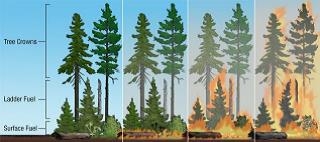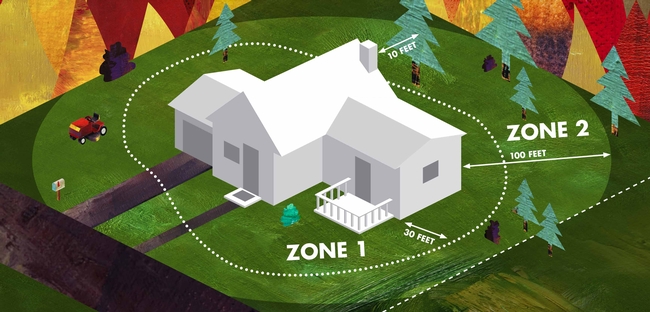Fire is a normal part of the natural environment in California, so if you live in the wildland-urban interface (WUI), it's not so much a question of if, but of when your home will be exposed to wildfire. With this thought and the devastation of the Camp Fire and other recent Northern California fires in mind, many Butte County property owners may be thinking about creating a fire-resistant landscape around their homes. Not only is this a prudent course of action, a 2005 revision of the California Public Resources Code (PRC 4291) requires that property owners create 100 feet (or to the property line) of defensible space around homes and buildings. Defensible space is defined as the area around a structure where the landscape is designed and maintained to decrease fire danger. Creating defensible space also gives firefighters an opportunity to safely protect your home.
The key to establishing defensible space is to utilize plants that are fire resistant and judiciously space them both horizontally and vertically. Increasing the space between plants limits the ability of fire to spread. As a rule of thumb, Cal Fire recommends that on flat ground the space from the edge of one shrub to the edge of the next be twice the height of the shrub. For example, if shrubs are two feet tall, they should be spaced four feet apart. If the shrubs are growing on a moderate slope the space between them should be four times the height of the shrub. The space between trees should be 10 feet from canopy to canopy and increase to 20 feet on a moderate slope.
If a fire reaches the crown of a tree, its heat intensity increases and this can increase the combustibility of surrounding vegetation. Low tree branches create fuel ladders that allow fires to climb into a tree. To prevent fires from ‘crowning,' these ladder fuels must be eliminated. Cal Fire recommends that the lower branches of a mature tree should be pruned to create a clearance of three times the height of the shrubs beneath it. For example if a shrub is four feet tall, the tree should be pruned so that there is 12 feet of clearance between the top of the shrub and the lowest branches of the tree. For younger trees, the lower one-third of branches should be removed.
The area that is 30 feet closest to a home is often called the “home defense zone” or, as Cal Fire puts it, the “Lean, Clean and Green Zone.” In this area, highly flammable fuels should be eliminated or minimized and widely spaced plants should be kept green and well irrigated. Vegetation in this zone should be comprised of shorter plants such as grasses and non-woody flowers. If shrubs or trees are planted, they should be fire-resistant plants such as deciduous trees (which shed their leaves in the fall) or non-woody natives and other perennials such as salvias. Fire-resistant ground covers are also an acceptable choice for this area. Avoid planting broadleaf evergreens (like holly and coyote bush), conifers (like pines, junipers, cedars, and firs) and palms, because they are highly flammable.

When planning a firewise landscape, the contribution of hardscape features should not be overlooked. Decomposed granite, cement, asphalt or gravel pathways and driveways make effective firebreaks. Structures such as patios and masonry walls and water features like pools, ponds, and streams will also impede the advance of a fire.
Before moving beyond the 30-foot home defense zone, mention should be made of items that do not belong too close to a home. Most propane tanks should be located a minimum of 10 feet from any structure, and woodpiles should be at least 30 feet away. A cord of seasoned firewood contains the energy equivalent of approximately 174 gallons of gasoline! Would you store that much gasoline on your porch? Also, flammable liquids such as gasoline, paint thinner, and turpentine should be properly stored away from ignition sources and combustibles.
The outer 70 feet of the defensible space is called the “reduced fuel zone.” As with the home defense zone, plants in this zone should be well spaced horizontally and separated vertically to eliminate fire ladders. Fire resistant plants should also be used here. Most surface litter such as leaves, pine needles, and twigs should be removed so that this layer is no more than three inches deep. Dead annual grasses should be mowed to a height of no more than four inches. Mature trees without shrubs growing beneath them should be limbed to a height of six feet above the ground. All plants should receive adequate water and dead branches in trees and shrubs should be regularly removed. As noted in the UC Cooperative Extension's fact sheet on defensible space, “The goal of brush clearance is not to remove all vegetation. When done well, cleared areas should still include enough well-spaced and judiciously pruned plants to protect against excessive erosion and provide wildlife habitat.”
If organic mulches are used in the reduced-fuel zone, a 2008 study showed that a mulch of composted wood chips spread two to three inches deep showed the slowest fire-spread rate of the eight mulches tested. A potential disadvantage of wood chip mulches is that they tend to smolder and can be difficult to extinguish. In general, fine, stringy mulches such as shredded bark burn more rapidly than larger chunks.
Establishing defensible space can be summarized by the following three R's: 1) Remove dead and dying plant material; 2) Reduce the density of vegetation and ladder fuels; 3) Replace hazardous vegetation with less flammable, well-irrigated fire resistant plants.
Further information on fire safety for homeowners can be found on the Cal Fire website at Home - Ready for Wildfire. And for property owners who are considering landscaping from scratch, the Sonoma-Marin Saving Water Partnership has developed eight fire-rebuild landscape design plans that are well worth considering.
For more information on creating fire resistant landscapes, see the Fire-Safe Landscape section of UC Master Gardeners of Butte County website, and the UC ANR publication Home Landscaping for Fire (PDF).
Watch this space! Next week's Real Dirt will focus on plants that are fire resistant.
UC Master Gardeners of Butte County are part of the University of California Cooperative Extension (UCCE) system. To learn more about us and our upcoming events, and for help with gardening in our area, visit our website. If you have a gardening question or problem, email the Hotline at mgbutte@ucanr.edu (preferred) or call (530) 538-7201.
